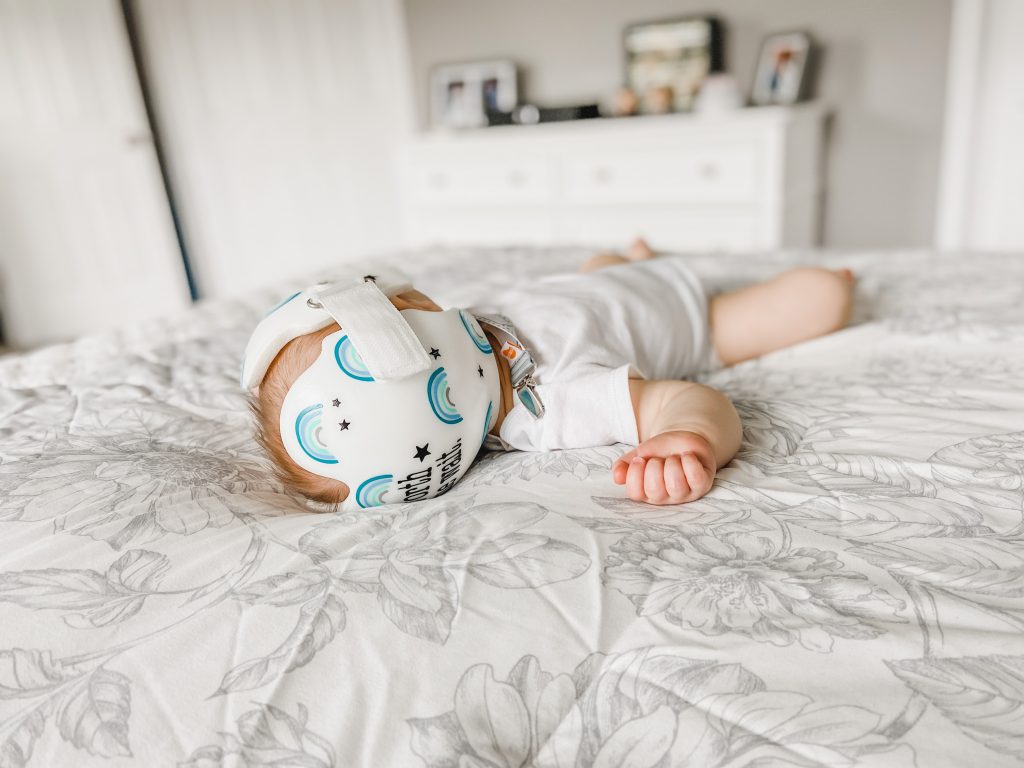
At our 6 month wellness visit with Ethan’s pediatrician we were told that his head shape was presenting as abnormal and we were referred to Cranial Technologies for a consultation for a DOC Band. There are 3 different conditions that DOC Bands are prescribed for: Plagiocephaly, Brachycephaly & Scaphocephaly. Essentially, these are conditions in which the skull exhibits irregular shaping, such as flattening, either from natural circumstances, such as womb positioning, or from too much time spent on their backs (lack of “tummy-time”). The DOC Band is a lightweight “helmet” that applies gentle pressure to safely redirect the natural head growth into a more normal head shape.
Once we got home and had time to process what we had been told, my head started spinning. How had we not realized his head shape was abnormal – it was so obvious to us now! Why hadn’t the pediatrician caught this earlier – wasn’t it normally diagnosed at 4 months? How would Ethan take to wearing his band – would it disrupt his sleeping? Thankfully, all of our fear and apprehension turned out to be for nothing. Ethan took to his band beautifully & now, at the halfway point, we’re so incredibly thankful that we contacted Cranial Technologies. We started to see a noticeable difference in his head shape after just 2 weeks and now, at 8 weeks, his head is significantly rounder!
So, what happens at the consultation?
During your initial consultation, your little one will be undressed down to the diaper and a mesh stocking cap will be placed over their head & forehead (face uncovered). You will be asked to place them on a stool and hold them still in a seated position while a technician takes photos using a rotating camera mechanism. Those photos are actually measuring your child’s skull and creating 3D images that the doctor will then interpret to determine if your child will require a corrective band.
Remember those 3 different conditions that screen for: Plagiocephaly, Brachycephaly & Scaphocephaly? Ethan was diagnosed with moderate-severe Plagiocephaly (“flat head syndrome”) caused by his positioning in utero. The typical treatment time for this condition is 4.5 months – the longest standard treatment out of the 3.
My baby needs a band, now what?
Will you leave with a band that day? Nope, sorry! Keep in mind that each band is custom-made and the facility that manufactures them is in Arizona, so depending on your location, it is going to take some time to have the band created and shipped back to your local office. In our case, it took about a month from the date of diagnosis to get Ethan fitted in his band. Once we knew he needed one, we had to submit a request to our insurance to first see if they would cover any of the cost. They denied it, which is almost always the case as most bands are for “cosmetic” purposes, but we did qualify for a military discount & paid in full – which brought our cost down. On average, the bands will cost between $1,200 and $3,000 – dependant upon your location, if you qualify for any discounts, etc.
Once you have determined the cost and arranged for payment, you will be brought back in for additional, more detailed, measurements. This time, a technician will hold your baby on the stool and the stocking cap will cover their face entirely. They can breathe just fine but as you can imagine, they’re going to panic and start to cry. Do your best to keep their attention on you & BREATHE mama, it will be over in a few minutes!
Those measurements are then sent to the Arizona facility where the band will be molded to your baby’s exact head shape. The band will apply pressure on the areas that need to be “pushed in” and allow room for growth in the areas that need to “fill out”. Once the band is back at your local office, you’ll come in to have an official fitting. The band will be placed on your baby’s head and the technicians will mark where any manual adjustments need to be made. They want to ensure the band doesn’t inhibit the baby in any way and is comfortable – your little one will be in this thing for 23 hours a day! While the band is being adjusted, you will watch a short video explaining how to properly care for the band, what can be used to clean it, when it can be removed, etc. Once you’ve completed the video, you will practice taking the band on and off and ask any questions you may have.
How will my baby react to wearing the band?
As with all things, your experience is going to be specific to your little one. The vast majority of babies take to the bands without issue and thankfully, Ethan did as well. I can honestly say that he never once seemed to even realize he had a band on. It didn’t impact his sleeping at all (thank goodness!) and the only change we had to make in our daily routine was to factor in time to clean the band and allow it to air dry outdoors (weather permitting).
Tips & Tricks
- Only use 70% isopropyl alcohol when cleaning the band & allow it to dry in direct sunlight – it helps with the smell & it will get smelly very quickly.
- Plan on removing the band in conjunction with bath time if you can, to limit the amount of time the band is off – you only have 1 hour!
- Consider using vinyl decals to decorate the band – they’re easy to apply, can be sealed with Mod Podge (dries in minutes) and easy to change out if desired.
- Consider designating a special stuffed animal to wear your baby’s band after they “graduate” from wearing it – it makes a great keepsake!
Keep an eye out for the next post, discussing the second half of our DOC Band journey, in the upcoming months.
Is your baby in a band or do you think they need one? Let me know!




